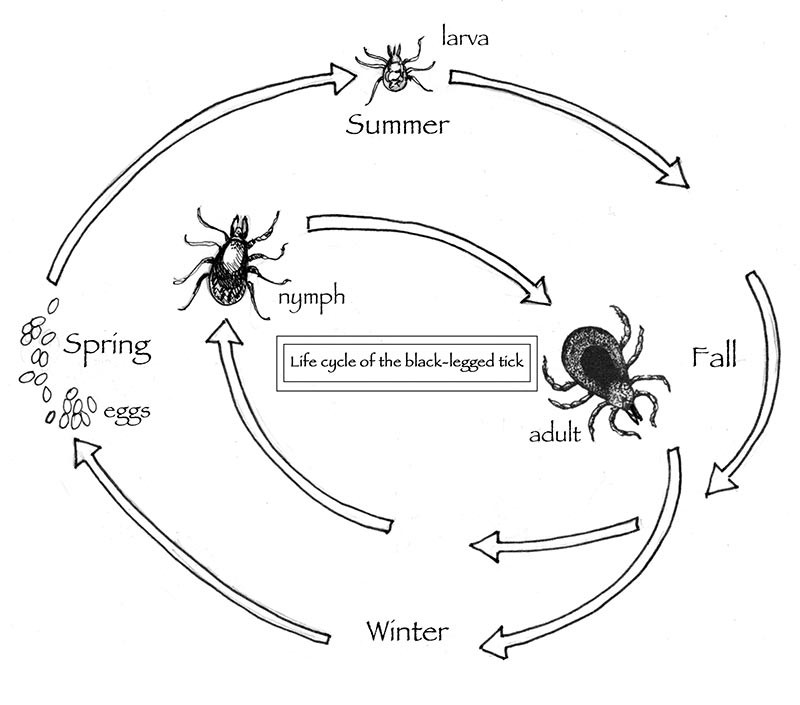
Over the past few decades, black-legged tick populations have grown relentlessly throughout much of southern Vermont and New Hampshire, and farther north in the Connecticut and Champlain Valleys. These are the ticks that carry Lyme disease, and so what was once a novelty illness has become a rite of passage for many. It’s probably safe to say that by now everyone reading this knows someone who’s had the disease, if they haven’t had it themselves.
But some years are worse than others when it comes to Lyme disease infection rates, so the obvious question is: what causes this? Part of the answer involves the number of deer and small mammals around. There’s been elegant science done that establishes a neat connection between Lyme disease rates and good acorn years. The oaks produce a good crop, which causes a spike in the mouse and chipmunk populations the next year, and then a surge in human Lyme disease cases a year after that.
Weather also plays a role, but maybe not in the way you might think. Around here there’s a lot of speculation every winter that maybe the cold will knock back the ticks. Unfortunately, any hope placed in this idea is probably misplaced. Remember that deep cold we had in late December last year, when much of the region dipped well below zero at night and didn’t get above freezing for two weeks? During this cold snap researchers were studying tick mortality in Maine, and noted that temperatures below the snow were pretty much a constant 30 degrees, well above the 14 degree threshold below which ticks start to die. Even in areas where ticks had no protection from leaves or snow, they were surviving at rates between 30 and 40 percent.
Dry early summer weather, though, like the kind we’re having this year, does affect ticks, or at least the rate at which humans contract Lyme disease.
“Most tick species show reduced host seeking behavior when it's dry,” said James Burtis, a postdoctoral associate at Cornell University who’s studying the subject. “Black-legged ticks are particularly sensitive to desiccation, likely in part due to their smaller size and their adaptation to moist forest environments.”
Ticks can seem supernaturally tough. Pinch one with all your strength between the fleshy parts of your fingers and nothing happens. Drop one in a glass of water and it’ll just sit on the bottom wriggling instead of drowning, waiting for you to toss the water outside so it can walk away. But its Achilles heel is desiccation – a fancy word for drying out. They need moisture, which is why you find them in the moist leaf litter at the edge of the yard and not in the drier, mown parts. Expose a tick nymph to air with 40 percent humidity and deprive it of moisture for 24 hours and it will likely die.
In early summer, the tiny nymphs – about the size of a poppy seed – have to climb up a stem of grass or brush and then just hang there waiting for you or something else warm blooded to brush into them so they can eat. The wind dries them out. The sun dries them out. As a result, in hot, dry years, they need to climb up and down the vegetation more often to rehydrate. There’s evidence they don’t climb as high, since the farther they get from the moist duff layer, the more exposed they are; this presumably would make them more likely to be stepped on than brushed into. They may also do more questing at night when there’s more moisture, which further limits human exposure.
Some of the ticks might be dying in the drought. “There is some evidence that ticks burn through their energy reserves when it is hot & dry, said Burtis, “but those are just preliminary data.” It’s best not to make too much of this, though. In one long-term study carried out at the Cary Institute for Ecosystem Studies, researchers noted that while they collected fewer tick nymphs by “flagging” (dragging corduroy cloth through the brush) in dry years, the tick counts on rodents they trapped didn’t show a big variation between wet and dry years, which seems to indicate that many of the tick nymphs are still getting their blood meal, it’s just coming from a mouse and not a human.
Presumably the drought won’t last all summer, and so the nymphs could yet resurface with a vengeance. But in the meantime, being able to take my 17-month-old daughter into the woods with my tick alarm on “alert” instead of “paranoid,” is a nice silver lining to the too-dry weather.


Discussion *